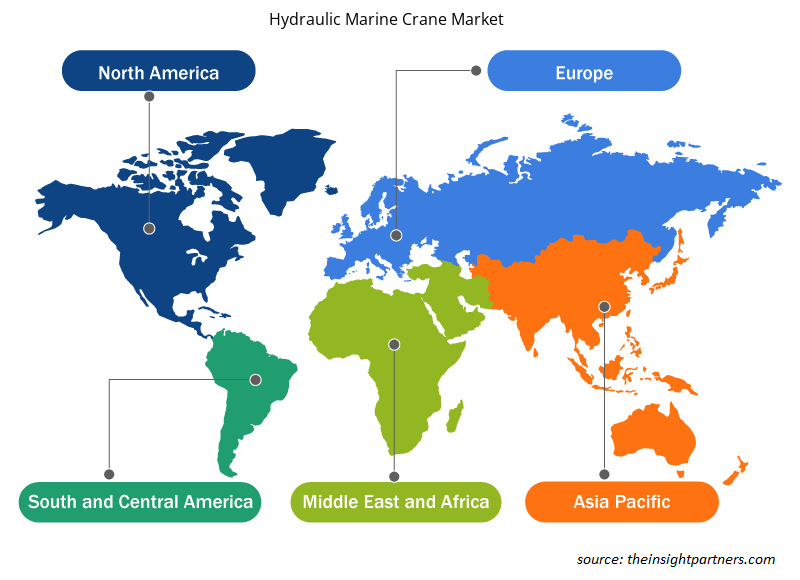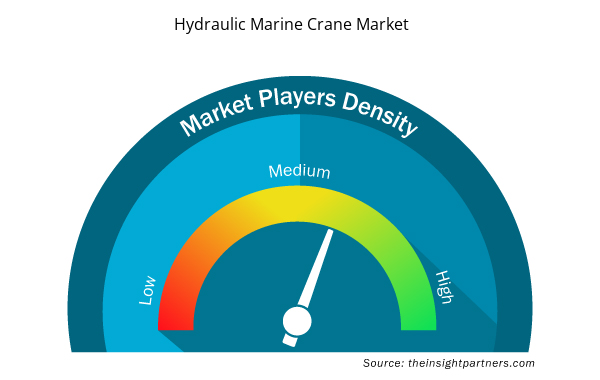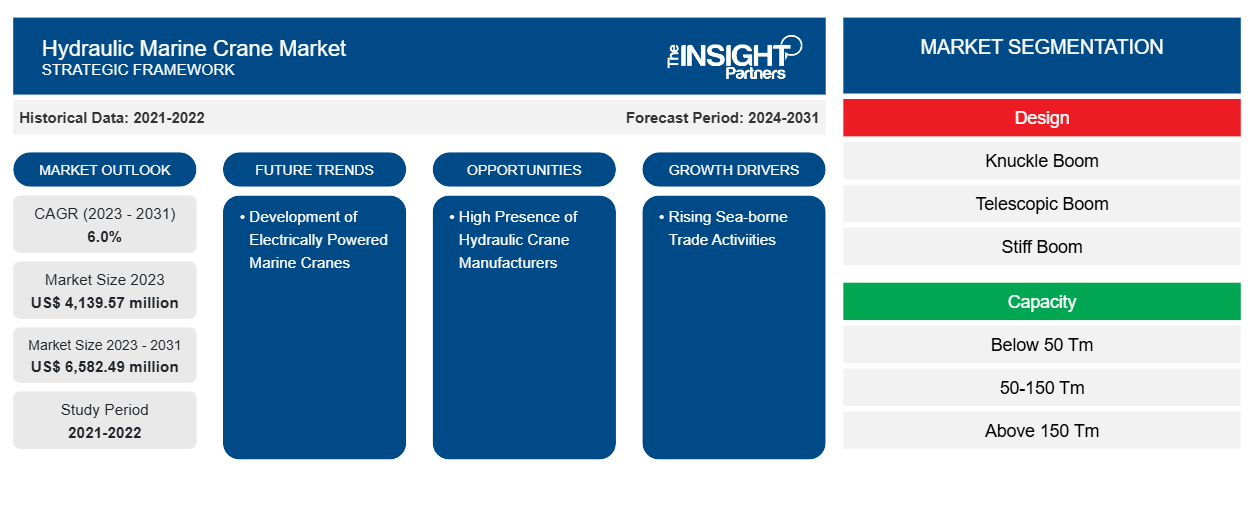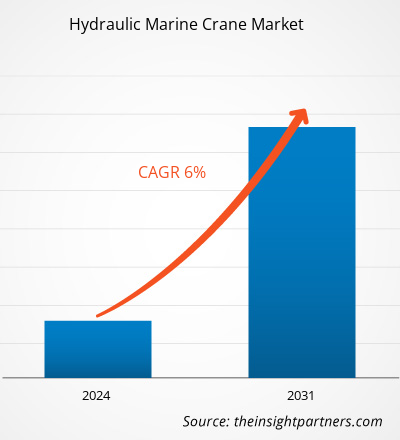Der Markt für hydraulische Schiffskräne soll von 4.139,57 Millionen US-Dollar im Jahr 2023 auf 6.582,49 Millionen US-Dollar im Jahr 2031 anwachsen. Der Markt wird zwischen 2023 und 2031 voraussichtlich eine durchschnittliche jährliche Wachstumsrate (CAGR) von 6,0 % verzeichnen. Die wachsende Zahl der seegestützten Handelsaktivitäten und der zunehmende Fokus der Regierung auf die Entwicklung der Meeresinfrastruktur werden voraussichtlich weiterhin ein wichtiger Trend auf dem Markt bleiben.
Hydraulische Schiffskräne Marktanalyse
Mehrere staatliche Investitionen in den Aufbau der maritimen Infrastruktur haben die Nachfrage nach hydraulischen Schiffskränen erhöht. Eine große Anzahl von Schiffsherstellern würde direkt zu einer erhöhten Nachfrage nach hydraulischen Schiffskränen weltweit führen. In den entwickelten Regionen wie Nordamerika und Europa gibt es führende Schiffskranhersteller wie die DMW Marine Group und Fred Wahl Marine Construction, Inc., die Schiffskräne mit Knickarm, Teleskopausleger und starrem Ausleger anbieten. All dies wird das Wachstum des Marktes für hydraulische Schiffskräne steigern.
Marktübersicht für hydraulische Schiffskrane
Die zunehmenden technologischen Entwicklungen ermöglichen es den Arbeitnehmern, flexibel zu bleiben. Die Integration fortschrittlicher Technologie in Schiffe und mehrere Offshore-Projekte würde das Wachstum des Marktes für hydraulische Schiffskräne weltweit vorantreiben. Länder wie Saudi-Arabien beschaffen sich Seetransportflotten, die den Einsatz fortschrittlicher Technologien in mehreren Schiffen, wie Frachtschiffen und Kriegsschiffen, fördern würden. Für die Implementierung und den Bau neuer technologischer Infrastrukturen wären Schiffskräne erforderlich, was die Nachfrage nach hydraulischen Schiffskränen steuert.
Passen Sie diesen Bericht Ihren Anforderungen an
Sie erhalten kostenlos individuelle Anpassungen an jedem Bericht, einschließlich Teilen dieses Berichts oder einer Analyse auf Länderebene, eines Excel-Datenpakets sowie tolle Angebote und Rabatte für Start-ups und Universitäten.
- Holen Sie sich die wichtigsten Markttrends aus diesem Bericht.Dieses KOSTENLOSE Beispiel umfasst eine Datenanalyse von Markttrends bis hin zu Schätzungen und Prognosen.
Markttreiber und Chancen für hydraulische Schiffskrane
Wachsende Seehandelsaktivitäten begünstigen den Markt
Regierungsrichtlinien und -vorschriften zugunsten internationaler Handelsaktivitäten ziehen ausländische Investitionen an. Außerdem konzentrieren sich mehrere Regierungen auf die Entwicklung der Schifffahrtsindustrie und ziehen ausländische Direktinvestitionen in diesem Sektor an, was die Handelsaktivitäten auf dem Seeweg steigert und den Markt für Hydraulikkräne positiv beeinflusst. Die wachsenden technologischen Entwicklungsprojekte, die in Häfen und im Schiffsbau durchgeführt werden, wirken sich positiv auf die Handelsaktivitäten aus. Die wachsende Zahl der Handelsaktivitäten auf dem Seeweg erfordert eine angemessene Hafeninfrastruktur und Dockanlagen, um die große Anzahl an Handelsschiffen zu bedienen, die weltweit ein wichtiger Treiber für den Markt für Hydraulikkräne sind.FDI in this sector, which is increasing the sea-borne trading activities and influencing the hydraulic crane market positively. The growing technological development projects constructed across ports and in ship buildings are positively influencing trading activities. The growing number of sea-bourne trading activities require proper port infrastructure and dock facilities to cater to the large number of commercial ships, which is acting as a major driver for the hydraulic machine crane market globally.
Hohe Präsenz von Herstellern hydraulischer Kräne
Die Anzahl der Schiffskranhersteller in Regionen wie Europa, Asien-Pazifik und Nordamerika ist im Vergleich zu anderen Regionen hoch. Italien, China und die USA gehören zu den Ländern mit den größten Schiffskranherstellern. Die in diesen Regionen verfügbaren Schiffskrantypen sind Knickarm-, Teleskop- und Starrarm-Schiffskrane. Bei einer höheren Anzahl von Schiffskranherstellern wird daher ein positives Wachstum des Marktes erwartet. In den USA gibt es auch eine große Anzahl von Schiffsherstellern, was direkt zu einer erhöhten Nachfrage nach hydraulischen Schiffskranen führen würde.
Segmentierungsanalyse des Marktberichts für hydraulische Schiffskrane
Wichtige Segmente, die zur Ableitung der Marktanalyse für hydraulische Schiffskräne beigetragen haben, sind Design, Kapazität und Auslegerlänge.
- Basierend auf dem Design ist der Markt für hydraulische Schiffskräne in Knickarm-, Teleskop- , Starrarm- und Faltarmkräne unterteilt. Das Segment der Faltarmkräne hatte im Jahr 2023 einen größeren Marktanteil.
- Nach Kapazität ist der Markt in unter 50 Tm, 50-150 Tm und über 150 Tm segmentiert. Das Segment 50 – 150 Tm hielt im Jahr 2023 einen bedeutenden Marktanteil.
- Nach Auslegerlänge ist der Markt in unter 10 Meter, 10-20 Meter und über 20 Meter segmentiert. Das Segment unter 10 Metern hatte im Jahr 2023 einen erheblichen Marktanteil.
Hydraulische Schiffskran Marktanteilsanalyse nach Geografie
Der geografische Umfang des Marktberichts für hydraulische Schiffskräne ist hauptsächlich in fünf Regionen unterteilt: Nordamerika, Asien-Pazifik, Europa, Naher Osten und Afrika sowie Süd- und Mittelamerika.
Europa ist Marktführer. Hohe staatliche Investitionen in die Entwicklung der maritimen Infrastruktur haben die Nachfrage nach hydraulischen Schiffskränen in der Region positiv beeinflusst. Die wachsenden technologischen Entwicklungsprojekte in Häfen und im Schiffsbau erhöhen die Nachfrage nach hydraulischen Schiffskränen auf den europäischen Märkten. Europa ist eine wirtschaftlich fortschrittliche Region. Großbritannien, Spanien, Italien, Frankreich, Deutschland, die Schweiz, Russland, Schweden und die Niederlande sind einige der wichtigsten Länder in der Region. Die hohe Präsenz von Schiffbau- und Hydraulikkranherstellern wirkt sich ebenfalls positiv auf den Markt für hydraulische Schiffskräne in Europa aus.
Regionale Einblicke in den Markt für hydraulische Schiffskrane
Die regionalen Trends und Faktoren, die den Markt für hydraulische Schiffskrane im Prognosezeitraum beeinflussen, wurden von den Analysten von Insight Partners ausführlich erläutert. In diesem Abschnitt werden auch die Marktsegmente und die Geografie für hydraulische Schiffskrane in Nordamerika, Europa, im asiatisch-pazifischen Raum, im Nahen Osten und Afrika sowie in Süd- und Mittelamerika erörtert.

- Erhalten Sie regionale Daten zum Markt für hydraulische Schiffskrane
Umfang des Marktberichts für hydraulische Schiffskrane
| Berichtsattribut | Details |
|---|---|
| Marktgröße im Jahr 2023 | 4.139,57 Millionen US-Dollar |
| Marktgröße bis 2031 | 6.582,49 Millionen US-Dollar |
| Globale CAGR (2023 - 2031) | 6,0 % |
| Historische Daten | 2021-2022 |
| Prognosezeitraum | 2024–2031 |
| Abgedeckte Segmente | Von Design
|
| Abgedeckte Regionen und Länder | Nordamerika
|
| Marktführer und wichtige Unternehmensprofile |
|
Marktteilnehmerdichte: Der Einfluss auf die Geschäftsdynamik
Der Markt für hydraulische Schiffskrane wächst rasant, angetrieben durch die steigende Nachfrage der Endnutzer aufgrund von Faktoren wie sich entwickelnden Verbraucherpräferenzen, technologischen Fortschritten und einem größeren Bewusstsein für die Vorteile des Produkts. Mit steigender Nachfrage erweitern Unternehmen ihr Angebot, entwickeln Innovationen, um die Bedürfnisse der Verbraucher zu erfüllen, und nutzen neue Trends, was das Marktwachstum weiter ankurbelt.
Die Marktteilnehmerdichte bezieht sich auf die Verteilung der Firmen oder Unternehmen, die in einem bestimmten Markt oder einer bestimmten Branche tätig sind. Sie gibt an, wie viele Wettbewerber (Marktteilnehmer) in einem bestimmten Marktraum im Verhältnis zu seiner Größe oder seinem gesamten Marktwert präsent sind.
Die wichtigsten auf dem Markt für hydraulische Schiffskräne tätigen Unternehmen sind:
- Amco Veba Marine
- Dmw Marine Gruppe
- Fassi Gru SpA
- Fred Wahl Marine Construction, Inc.
- Heila Cranes SpA
- Hydrauliska Industri AB
Haftungsausschluss : Die oben aufgeführten Unternehmen sind nicht in einer bestimmten Reihenfolge aufgeführt.

- Überblick über die wichtigsten Akteure auf dem Markt für hydraulische Schiffskrane
Neuigkeiten und aktuelle Entwicklungen zum Markt für hydraulische Schiffskräne
Der Markt für hydraulische Schiffskrane wird durch die Erhebung qualitativer und quantitativer Daten nach Primär- und Sekundärforschung bewertet, die wichtige Unternehmensveröffentlichungen, Verbandsdaten und Datenbanken umfasst. Nachfolgend sind einige der Entwicklungen auf dem Markt für hydraulische Schiffskrane aufgeführt:
- Amco Veba Marine bringt 40tm Schiffskrane auf den Markt. (Quelle: Amco Veba Marine, Pressemitteilung, Mai 2022)
- Die Krankategorien V820NM und V823NM von Amco Veba Marine wurden von DNV nach der Norm DNV-ST-0377 für Schiffshebezeuge zertifiziert. (Quelle: Amco Veba Marine, Pressemitteilung, September 2022)
Marktbericht zu hydraulischen Schiffskränen – Umfang und Ergebnisse
Der Bericht „Marktgröße und Prognose für hydraulische Schiffskrane (2021–2031)“ bietet eine detaillierte Analyse des Marktes, die die folgenden Bereiche abdeckt:
- Marktgröße und Prognose für hydraulische Schiffskrane auf globaler, regionaler und Länderebene für alle wichtigen Marktsegmente, die im Rahmen des Berichts abgedeckt sind
- Markttrends für hydraulische Schiffskrane sowie Marktdynamik wie Treiber, Beschränkungen und wichtige Chancen
- Detaillierte PEST- und SWOT-Analyse
- Marktanalyse für hydraulische Schiffskrane mit Blick auf wichtige Markttrends, globale und regionale Rahmenbedingungen, wichtige Akteure, Vorschriften und aktuelle Marktentwicklungen
- Branchenlandschaft und Wettbewerbsanalyse, die die Marktkonzentration, Heatmap-Analyse, prominente Akteure und aktuelle Entwicklungen für den Markt für hydraulische Schiffskrane umfasst
- Detaillierte Firmenprofile
- Historische Analyse (2 Jahre), Basisjahr, Prognose (7 Jahre) mit CAGR
- PEST- und SWOT-Analyse
- Marktgröße Wert/Volumen – Global, Regional, Land
- Branche und Wettbewerbsumfeld
- Excel-Datensatz



Report Coverage
Revenue forecast, Company Analysis, Industry landscape, Growth factors, and Trends

Segment Covered
This text is related
to segments covered.

Regional Scope
North America, Europe, Asia Pacific, Middle East & Africa, South & Central America

Country Scope
This text is related
to country scope.
Häufig gestellte Fragen
Europe dominated the hydraulic marine crane market in 2023.
The development of electrically powered marine cranes is the future trend of the hydraulic marine crane market.
Amco Veba Marine, DMW Marine Group, Fassi Gru S.p.A., Fred Wahl Marine Construction, Inc., Heila Cranes S.p.A., Hydrauliska Industri AB, HS.MARINE S.r.L., HYVA, Industrias Guerra, S.A., Kenz Figee, Melcal, Mkg Maschinen-& Kranvertrieb, and Palfinger AB are some of the leading players in the market.
US$ 6,582.49 million estimated value of the hydraulic marine crane market by 2031.
6.0% is the expected CAGR of the hydraulic marine crane market.
Trends and growth analysis reports related to Manufacturing and Construction : READ MORE..
The Insight Partners performs research in 4 major stages: Data Collection & Secondary Research, Primary Research, Data Analysis and Data Triangulation & Final Review.
- Data Collection and Secondary Research:
As a market research and consulting firm operating from a decade, we have published and advised several client across the globe. First step for any study will start with an assessment of currently available data and insights from existing reports. Further, historical and current market information is collected from Investor Presentations, Annual Reports, SEC Filings, etc., and other information related to company’s performance and market positioning are gathered from Paid Databases (Factiva, Hoovers, and Reuters) and various other publications available in public domain.
Several associations trade associates, technical forums, institutes, societies and organization are accessed to gain technical as well as market related insights through their publications such as research papers, blogs and press releases related to the studies are referred to get cues about the market. Further, white papers, journals, magazines, and other news articles published in last 3 years are scrutinized and analyzed to understand the current market trends.
- Primary Research:
The primarily interview analysis comprise of data obtained from industry participants interview and answers to survey questions gathered by in-house primary team.
For primary research, interviews are conducted with industry experts/CEOs/Marketing Managers/VPs/Subject Matter Experts from both demand and supply side to get a 360-degree view of the market. The primary team conducts several interviews based on the complexity of the markets to understand the various market trends and dynamics which makes research more credible and precise.
A typical research interview fulfils the following functions:
- Provides first-hand information on the market size, market trends, growth trends, competitive landscape, and outlook
- Validates and strengthens in-house secondary research findings
- Develops the analysis team’s expertise and market understanding
Primary research involves email interactions and telephone interviews for each market, category, segment, and sub-segment across geographies. The participants who typically take part in such a process include, but are not limited to:
- Industry participants: VPs, business development managers, market intelligence managers and national sales managers
- Outside experts: Valuation experts, research analysts and key opinion leaders specializing in the electronics and semiconductor industry.
Below is the breakup of our primary respondents by company, designation, and region:

Once we receive the confirmation from primary research sources or primary respondents, we finalize the base year market estimation and forecast the data as per the macroeconomic and microeconomic factors assessed during data collection.
- Data Analysis:
Once data is validated through both secondary as well as primary respondents, we finalize the market estimations by hypothesis formulation and factor analysis at regional and country level.
- Macro-Economic Factor Analysis:
We analyse macroeconomic indicators such the gross domestic product (GDP), increase in the demand for goods and services across industries, technological advancement, regional economic growth, governmental policies, the influence of COVID-19, PEST analysis, and other aspects. This analysis aids in setting benchmarks for various nations/regions and approximating market splits. Additionally, the general trend of the aforementioned components aid in determining the market's development possibilities.
- Country Level Data:
Various factors that are especially aligned to the country are taken into account to determine the market size for a certain area and country, including the presence of vendors, such as headquarters and offices, the country's GDP, demand patterns, and industry growth. To comprehend the market dynamics for the nation, a number of growth variables, inhibitors, application areas, and current market trends are researched. The aforementioned elements aid in determining the country's overall market's growth potential.
- Company Profile:
The “Table of Contents” is formulated by listing and analyzing more than 25 - 30 companies operating in the market ecosystem across geographies. However, we profile only 10 companies as a standard practice in our syndicate reports. These 10 companies comprise leading, emerging, and regional players. Nonetheless, our analysis is not restricted to the 10 listed companies, we also analyze other companies present in the market to develop a holistic view and understand the prevailing trends. The “Company Profiles” section in the report covers key facts, business description, products & services, financial information, SWOT analysis, and key developments. The financial information presented is extracted from the annual reports and official documents of the publicly listed companies. Upon collecting the information for the sections of respective companies, we verify them via various primary sources and then compile the data in respective company profiles. The company level information helps us in deriving the base number as well as in forecasting the market size.
- Developing Base Number:
Aggregation of sales statistics (2020-2022) and macro-economic factor, and other secondary and primary research insights are utilized to arrive at base number and related market shares for 2022. The data gaps are identified in this step and relevant market data is analyzed, collected from paid primary interviews or databases. On finalizing the base year market size, forecasts are developed on the basis of macro-economic, industry and market growth factors and company level analysis.
- Data Triangulation and Final Review:
The market findings and base year market size calculations are validated from supply as well as demand side. Demand side validations are based on macro-economic factor analysis and benchmarks for respective regions and countries. In case of supply side validations, revenues of major companies are estimated (in case not available) based on industry benchmark, approximate number of employees, product portfolio, and primary interviews revenues are gathered. Further revenue from target product/service segment is assessed to avoid overshooting of market statistics. In case of heavy deviations between supply and demand side values, all thes steps are repeated to achieve synchronization.
We follow an iterative model, wherein we share our research findings with Subject Matter Experts (SME’s) and Key Opinion Leaders (KOLs) until consensus view of the market is not formulated – this model negates any drastic deviation in the opinions of experts. Only validated and universally acceptable research findings are quoted in our reports.
We have important check points that we use to validate our research findings – which we call – data triangulation, where we validate the information, we generate from secondary sources with primary interviews and then we re-validate with our internal data bases and Subject matter experts. This comprehensive model enables us to deliver high quality, reliable data in shortest possible time.


 Holen Sie sich ein kostenloses Muster für diesen Bericht
Holen Sie sich ein kostenloses Muster für diesen Bericht